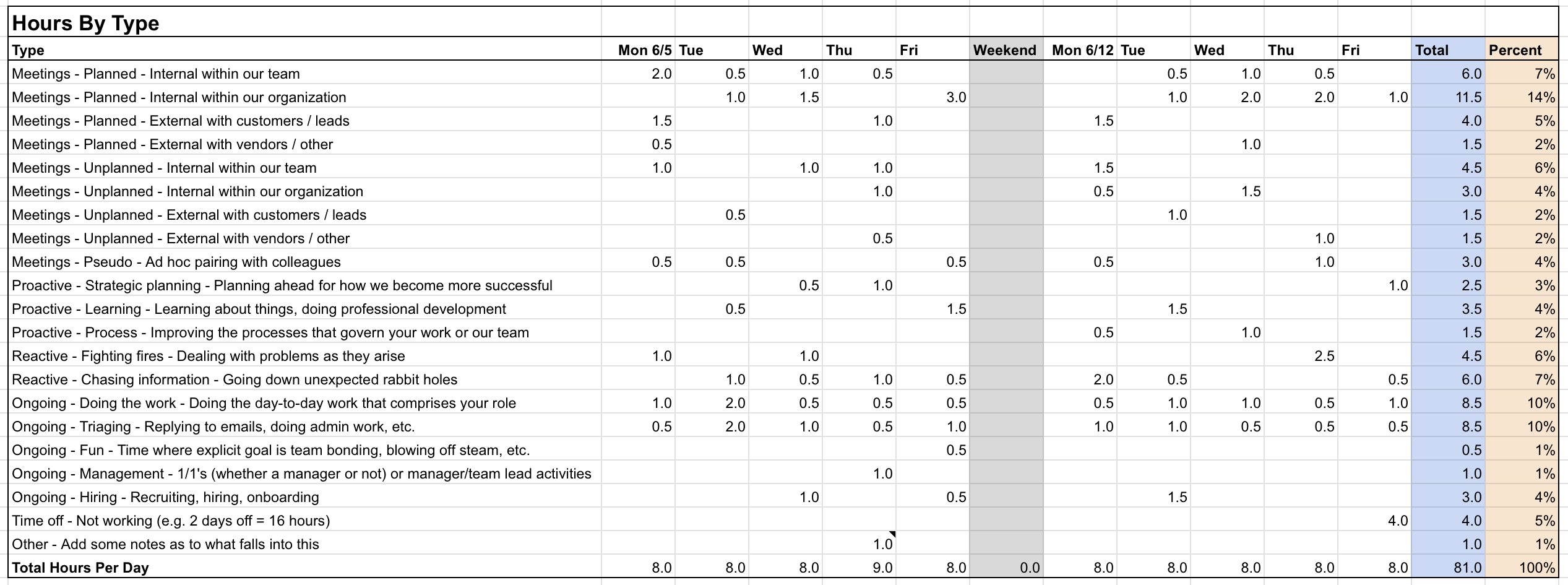Action expresses priorities - Gandhi.
Many organizations have this peculiar condition where employees feel both exceedingly busy AND exasperated by the lack of tangible accomplishments that stem from all that work.
In my experience, the main culprit is the lack of clear organizational priorities (see my post about prioritization). But another explanation is that employees simply don’t have a good grasp of how they’re spending their time and how that maps to stated priorities. Recurring meetings sprout from the calendar like weeds, folks get lost in a labyrinth of emails, and the amount of time to do “real work” vanishes.
In these situations, I’ve used a very simple exercise to help teams and individuals introspect and reset. I call it the “Where did the time go?” exercise, and it looks something like this:


You can see / create a copy of this template.
While it’s basically a glorified time tracking exercise, it has proven quite effective at helping individuals and teams (a) understand how their time is currently being spent and (b) problem solve tactical ways to shift behaviors and improve systems in order to create a better working environment.
There are a number of elements that make this process work:
- Psychological safety - If you don’t build this first within your team, folks will push back, lie about how they spent their time, etc. and the exercise won’t be worth doing.
- Agile framing - This should be presented as an opportunity for the team to reflect on the current way of working and try something new to improve upon it.
- Short-lived - It’s annoying to track your time, and if you ask folks to do it for long swaths of time, they’ll just start fudging the numbers. I tell folks that I’m only asking them to do this for a 2 week stretch, and I expect them to input accurate data during that time.
- Standardization - Team members should use the same time buckets (i.e. not too specific to a given role) and the directions should be clear so that team-level aggregation is possible.
- Reminders - Use some sort of check-in mechanism to remind folks to fill out their time each day; humans have a hard time remembering to track their time AND recalling what happened the previous day in detail.
- Privacy - While some teams will feel comfortable sharing individual-level time tracking results with each other, many won’t; honor their decision.
- Individual Review - Use an individual’s results to anchor a conversation on what they learned and what changes they seek to make upon seeing the results.
- Team Review - Aggregate results across the team to anchor a conversation on what the team can systematically do to improve the way in which work gets done.
- Recurring - Plan to revisit this exercise every 3-6 months (or as needed) and compare results.
As you review the results, consider these questions:
- How much time are we spending in meetings? Which make sense to have and which don’t?
- How much time are we spending in reactive / fire fighting mode? How can we invest in reducing this?
- How much time are we spending hiring / onboarding? Is that a match for how much we need more capacity? Could this be a more efficient process?
- How much time are we spending with certain customers, departments, etc?
- How much time are we spending doing manual work that could possibly be automated?
- How much time are we spending doing creative or fun team bonding stuff?
If you end up using and/or adapting this exercise, please do share your learnings!



